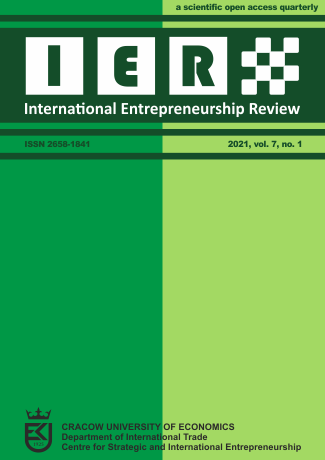Forecasting the number of cases and deaths from Covid-19

Abstract
Objective: The aim of this publication is to analyze the value of the number of new cases and deaths from COVID-19 in selected European Union countries: Poland, France and Belgium.
Research Design & Methods: Data were collected from the on-line database: https://covid.ourworldindata.org/ data/owid-covid-data.xlsx, which demonstrate the daily number of new cases and deaths due to the COVID-19 pandemic. The forecast was based on a linear trend function and a 7-period moving average, using Statistica 13 software.
Findings: The test results facilitated an evaluation of the diversity in the number of cases and the number of deaths in the assessed countries. Implications & Recommendations: From the obtained results, it can be concluded that the pandemic caused by the SARS-CoV-2 virus will end in 2021, about a year after the first case that appeared in Europe, provided that the vaccines are also effective against the mutated form of the virus.
Implications & Recommendations: Based on the results obtained by China, where the pandemic ended after a year, it can be assumed that EU countries will also win the fight against Covid-19 at a similar time provided that the vaccines are also effective against the mutated forms of the virus. This is indicated by the results of research obtained in this paper. However, it should be remembered that the pandemic is unpredictable and it is difficult to predict the values of variables for a longer period of time.
Contribution & Value Added: The article indicates the methods of combating Covid-19 in selected countries of the European Union.
Keywords
Epidemiology, COVID-19, forecasting, trend function, moving average method
Author Biography
Aldona Migała-Warchoł
PhD in Economics, Assistant Professor at the Quantitative Methods Department, Rzeszow University of Technology in Poland. Her main scientific interests concern the application of statistical analysis methods (including multidimensional statistical analysis) in aspects related to issues of quality and standard of human life (using survey data, measured on weak scales and data from statistical reports, measured on strong scales). Recently, her scientific interests cover the modelling of socio-economic development and its determinants in the European Union countries.
Monika Pichla
PhD Student in Biology, Rzeszów University, Poland. Her main scientific interests involve the screening for novel anti- cancer and neurodegenerative drugs and their future application in medicine. Privately, she is interested in the news of pharmaceutical industry and in clinical psychology.
References
- Bedford, T. & Hodcroft, E. (2021). Phylogeny of SARS‐like betacoronaviruses including novel coronavirus (nCoV). GISAID Global Initiative on Sharing All Influenza Data. Retrieved from https://nextstrain.org/groups/blab/sars-like-cov on 13 January 2021.
- CDC (2018). Asian Lineage Avian Influenza A(H7N9) Virus. Last reviewed on December 7, 2018. Centers for Disease Control and Prevention, National Center for Immunization and Respiratory Diseases (NCIRD). Retrieved from https://www.cdc.gov/flu/avianflu/h7n9-virus.htm on 1 February 2021.
- Cheng, C., Barceló, J., Hartnett, A. S., Kubinec, R., & Messerschmidt, L. (2020). COVID-19 Government Response Event Dataset (CoronaNet v.1.0). Nature Human Behaviour, 4(7), 756-768. https://doi.org/10.1038/s41562-020-0909-7
- Chun, J.Y., Baek, G., & Kim, Y. (2020). Transmission onset distribution of COVID-19. International journal of infectious diseases. IJID, vol. 99, 403-407. The official publication of the International Society for Infectious Diseases. https://doi.org/10.1016/j.ijid.2020.07.075
- Esakandari, H., Nabi-Afjadi, M., Fakkari-Afjadi, J., Farahmandian, N., Miresmaeili, S. M., & Bahreini, E. (2020). A comprehensive review of COVID-19 characteristics. Biological Procedures Online, 22, 19. https://doi.org/10.1186/s12575-020-00128-2
- Fernandez-Montero, J. V., Soriano, V., Barreiro, P., de Mendoza, C., & Artacho, M. Á. (2020). Coronavirus and other airborne agents with pandemic potential. Current Opinion in Environmental Science & Health, 17, 41-48. https://doi.org/10.1016/j.coesh.2020.09.001
- Hydzik P., Sobolewski M. (2007). Komputerowa analiza danych społeczno-gospodarczych. Rzeszów: Oficyna Wydawnicza Politechniki Rzeszowskiej.
- Jiang, F., Deng, L., Zhang, L., Cai, Y., Cheung, C. W., & Xia, Z. (2020). Review of the Clinical Characteristics of Coronavirus Disease 2019 (COVID-19). Journal of General Internal Medicine, 35(5), 1545-1549. https://doi.org/10.1007/s11606-020-05762-w
- Kinnunen, J., Georgescu, I., Hosseini, Z., & Androniceanu, A.-M. (2021). Dynamic indexing and clustering of
- government strategies to mitigate Covid-19. Entrepreneurial Business and Economics Review, 9(2), 7-19.
- https://doi.org/10.15678/EBER.2021.090201
- Lipkind, T., & Kitrar, L. (2021). The relationship of economic sentiment and GDP growth in Russia in light of the Covid-19 crisis. Entrepreneurial Business and Economics Review, 9(1), 7-29. https://doi.org/10.15678/EBER.2021.090101
- Luby S. P. (2013). The pandemic potential of Nipah virus. Antiviral Research, 100(1), 38-43. https://doi.org/10.1016/j.antiviral.2013.07.011
- Marjański, A., & Sułkowski, Ł. (2021). Consolidation strategies of small family firms in Poland during Covid-19 crisis. Entrepreneurial Business and Economics Review, 9(2), 167-182. https://doi.org/10.15678/EBER.2021.090211
- Marona, B., & Tomal, M. (2020). The COVID-19 pandemic impact upon housing brokers’ workflow and their clients’ attitude: Real estate market in Krakow. Entrepreneurial Business and Economics Review, 8(4), 221-232. https://doi.org/10.15678/EBER.2020.080412
- Migała-Warchoł A., Sobolewski M., (2020). The influence of the economic situation on the socio-economic development in the European Union countries by means of the modified HDI index, Proceedings of the 3rd Annual Conference ‘Technology transfer: innovative solutions in Social Sciences and Humanities’, 30 April 2020 Tallinn, Estonia, 28-31.
- Ritchie, H., Ortiz-Ospina, E., Beltekian, D., Mathieu, E., Hasell, J., Macdonald, B., Giattino, Ch., Appel, C., & Roser, M. (2020). Policy Responses to the Coronavirus Pandemic. Research and data. Retrieved from https://ourworldindata.org/policy-responses-covid on 9 January 2021.
- Szostak, M, & Sułkowski, Ł. (2021). Identity crisis of artists during the Covid-19 pandemic and shift towards entrepreneurship. Entrepreneurial Business and Economics Review, 9(3). Ahead-of-Print.
- Tyrrell, D. A., & Bynoe, M. L. (1966). Cultivation of viruses from a high proportion of patients with colds. Lancet (London, England), 1(7428), 76-77. https://doi.org/10.1016/s0140-6736(66)92364-6
- Velavan, Th.P., & Meyer, Ch.G. (2021). The COVID‐19 epidemic (nih.gov) [Accessed on-line: 08/01/2021]
- Żak, M., & Garncarz, J. (2020). Economic policy towards the challenges of the COVID-19 pandemic in selected European Union countries. International Entrepreneurship Review, 6(4), 21-34 https://doi.org/10.15678/IER.2020.0604.02
- Zeliaś A., Wanat S., Pawełek B. (2020). Prognozowanie ekonomiczne. PWN: Warszawa
- Zhou, P., Yang, XL., Wang, XG. et al. (2020). A pneumonia outbreak associated with a new coronavirus of probable bat origin. Nature, 579, 270-273. https://doi.org/10.1038/s41586-020-2012-7
